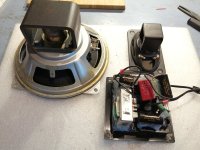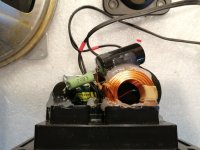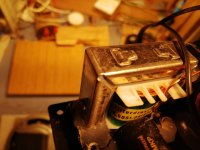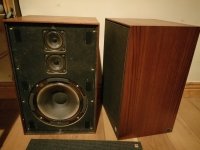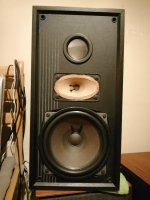Hi,
I got a pair of speakers years ago that consisted of Isophon drivers (P203s and P713), Mission cabinets, and a modern crossover that was made using the original inductors and all new resistors and caps. I'm making some new baffles for the drivers that will be placed in vintage cabinets.
However I have no experience with crossovers, and having drawn out the crossover circuit (inductor values unknown) I'm wondering if it was based on an old crossover circuit or is it a basketcase design. I can't find any 2 way designs that use this tweeter network. Is it a midrange filter?
Driver details:
https://www.hifi-archiv.info/Isophon/1961 Isophon Programm/08.jpg
https://www.hifi-archiv.info/Isophon/1961 Isophon Programm/06.jpg
I got a pair of speakers years ago that consisted of Isophon drivers (P203s and P713), Mission cabinets, and a modern crossover that was made using the original inductors and all new resistors and caps. I'm making some new baffles for the drivers that will be placed in vintage cabinets.
However I have no experience with crossovers, and having drawn out the crossover circuit (inductor values unknown) I'm wondering if it was based on an old crossover circuit or is it a basketcase design. I can't find any 2 way designs that use this tweeter network. Is it a midrange filter?
Driver details:
https://www.hifi-archiv.info/Isophon/1961 Isophon Programm/08.jpg
https://www.hifi-archiv.info/Isophon/1961 Isophon Programm/06.jpg
Attachments
Ah ok that makes sense.
And I suppose then tweeter is wired out of phase so it matches the phase shift of the woofer's 2nd order crossover...
Thanks, I can going with this project now!
And I suppose then tweeter is wired out of phase so it matches the phase shift of the woofer's 2nd order crossover...
Thanks, I can going with this project now!
It would be worthwhile experimenting with the +/- tweeter wiring in order to determine what sounds best to you in the new cabinet.
I reckon that the value of the 4.7 uF capacitor that precedes the 5.6 ohm attenuating resistor could usefully be increased to better integrate the "tweeter" with the "woofer" - something else to consider experimenting with when your new cabinets are complete.
I reckon that the value of the 4.7 uF capacitor that precedes the 5.6 ohm attenuating resistor could usefully be increased to better integrate the "tweeter" with the "woofer" - something else to consider experimenting with when your new cabinets are complete.
PSL203 wer the woofers in my first DIY stereo set. This was 1971. I wonder whether the rubber surroundings of your woofers still exist.
I have a pair of (similar) woofers, not seen that tweeter, surrounds are fine.
Any chance of a picture of the front of the drivers?
dave
Any chance of a picture of the front of the drivers?
dave
It would be worthwhile experimenting with the +/- tweeter wiring in order to determine what sounds best to you in the new cabinet.
I reckon that the value of the 4.7 uF capacitor that precedes the 5.6 ohm attenuating resistor could usefully be increased to better integrate the "tweeter" with the "woofer" - something else to consider experimenting with when your new cabinets are complete.
Cheers I'll try that out. Think I have some 10uf polys but that might be too much(?) or some electrolytics in series for testing.
The woofer surrounds are in great condition. No sign that they have ever been changed. Still supple with no hardening or rot.
The speakers have some really lovely characteristics, and recently surprised me again after trying them on a freshly restored Philips RH590 - they probably hadn't been run on Germaniums for few decades!
The 'donor' cabinets below are Bush L520 made by Rank in Denmark. Also alnico drivers.
The front baffles are screw on, so they can be restored back to original.
The Isophon woofer has been installed on the Mission cabs from the outside, but seems designed to be fit from the inside.
Haven't decided on that yet for the new baffles - is difference between depth of woofer and tweeter an important factor?
The speakers have some really lovely characteristics, and recently surprised me again after trying them on a freshly restored Philips RH590 - they probably hadn't been run on Germaniums for few decades!
The 'donor' cabinets below are Bush L520 made by Rank in Denmark. Also alnico drivers.
The front baffles are screw on, so they can be restored back to original.
The Isophon woofer has been installed on the Mission cabs from the outside, but seems designed to be fit from the inside.
Haven't decided on that yet for the new baffles - is difference between depth of woofer and tweeter an important factor?
Attachments
Think I have some 10uf polys but that might be too much(?)
With the current 4.7 uF cap the 4 ohm tweeter will operate effectively above a high frequency of around 8,500 Hz.
Using 10 uF would change that to around 4,000 Hz. Extending the tweeter's operating range may be beneficial and the tweeter can handle it.
As I say, worth experimenting. Let your ears decide.
is difference between depth of woofer and tweeter an important factor?
It can affect the acoustic phase relationship between woofer and tweeter and that's why it's worth experimenting with the tweeter electrical polarity when you've decided on your new baffle arrangement.
However, I wouldn't worry too much about depth difference in your application.
P.S. Will the open back tweeter be mounted in its own internal sealed enclosure to ensure its cone is not subject to the back pressure produced by the woofer?
I had 8" Isophon bass drivers until last year, one pair from 69 with cloth surrounds, one pair from 73 or 74 with rubber surrounds. Both were practically mint and had no surface roughness or any tears whatsoever. The newer ones had just two minor resonances, the older ones with the fabric surrounds sounded a lot more detailed and free, open. They had a quite high Qts, the newer ones were lower. I was surprised by their perfect condition, so other drivers of that time could be in similar condition unless they fell victim to extreme EQ and loudness buttons. The tweeters of the time die very quickly though because of the very small VCs, shallow filters and low XO frequency.PSL203 wer the woofers in my first DIY stereo set. This was 1971. I wonder whether the rubber surroundings of your woofers still exist.
If you're going to change components in a bandstop filter it may pay to measure that they are still centred on the response feature they are suppressing.Think I have some 10uf polys but that might be too much(?)
If you are using the original XO, it isn't because of the shallow filters (6 and 12db). The XO is indeed designed for behind the baffle mount drivers but they sound more detailed mounted from the front. The downside is that the FR will probably be worse and the dispersion will be better.is difference between depth of woofer and tweeter an important factor?
About 50 years ago, Isophon was one of the biggest loudspeaker manufacturers here in Germany, if not the biggest one at all. They used to promote their drivers to the DIY enthusiasts, which were ample in those days, and provided matching cabinet and xover design suggestions. Perhaps you still might find such a suggestion for your drivers and proceed accordingly.
If you're going to change components in a bandstop filter it may pay to measure that they are still centred on the response feature they are suppressing.
There was no suggestion of changing the capacitor in the parallel notch filter if that is what you are referring to.
My first 15" guitar speaker was the P385/100A from isophon with a whopping price tag of 600DM in the seventiesAbout 50 years ago, Isophon was one of the biggest loudspeaker manufacturers here in Germany, if not the biggest one at all. They used to promote their drivers to the DIY enthusiasts, which were ample in those days, and provided matching cabinet and xover design suggestions. Perhaps you still might find such a suggestion for your drivers and proceed accordingly.
Ah ok of course, it's just a simple high-pass filter, not effecting the notch filter. 8,500 Hz seems quite high and might explain how it sounds.With the current 4.7 uF cap the 4 ohm tweeter will operate effectively above a high frequency of around 8,500 Hz.
Yes, the tweeters come with the original very dense resin covers.P.S. Will the open back tweeter be mounted in its own internal sealed enclosure to ensure its cone is not subject to the back pressure produced by the woofer?
Been meaning to get a measurement microphone, this might justify it!If you're going to change components in a bandstop filter it may pay to measure that they are still centred on the response feature they are suppressing.
I doubt 2 parallel caps were used originally, it may well have been a slightly different value than the current 9.4uf (4.7 x 2).
Thanks, really appreciate all these tips. I now know what I need to go and study🙂If you are using the original XO, it isn't because of the shallow filters (6 and 12db). The XO is indeed designed for behind the baffle mount drivers but they sound more detailed mounted from the front. The downside is that the FR will probably be worse and the dispersion will be better.
Is 'FR' referring to free-air resonance?
Also, what are '...very small VCs...'?
About 50 years ago, Isophon was one of the biggest loudspeaker manufacturers here in Germany, if not the biggest one at all. They used to promote their drivers to the DIY enthusiasts, which were ample in those days, and provided matching cabinet and xover design suggestions. Perhaps you still might find such a suggestion for your drivers and proceed accordingly.
They're a fascinating brand, the old catalogues are a joy. I have come across a few crossovers but with quite different drivers and mostly 3-way. I'm now fairly confident the current crossover is a copy of original.
Just out of curiosity: How did it sound with your (bass?) guitar? Did it satisfy you?My first 15" guitar speaker was the P385/100A from isophon with a whopping price tag of 600DM in the seventies
Best regards!
Is 'FR' referring to free-air resonance?
I presume that FR = frequency response.
8,500 Hz seems quite high and might explain how it sounds.
Do you perceive a lack of upper midrange frequencies with the current configuration?
- Home
- Loudspeakers
- Multi-Way
- Isophon speaker build - Help needed with crossover

